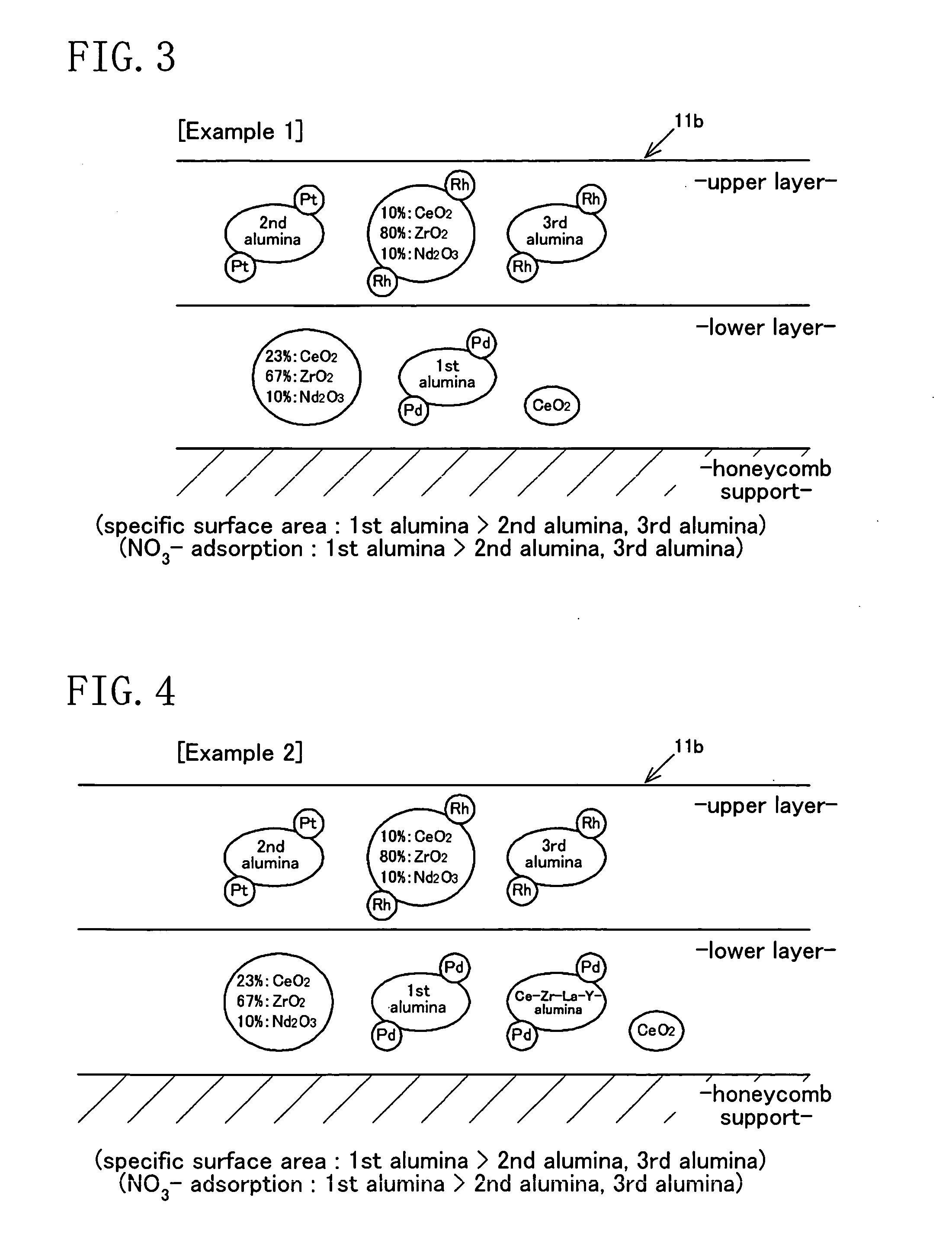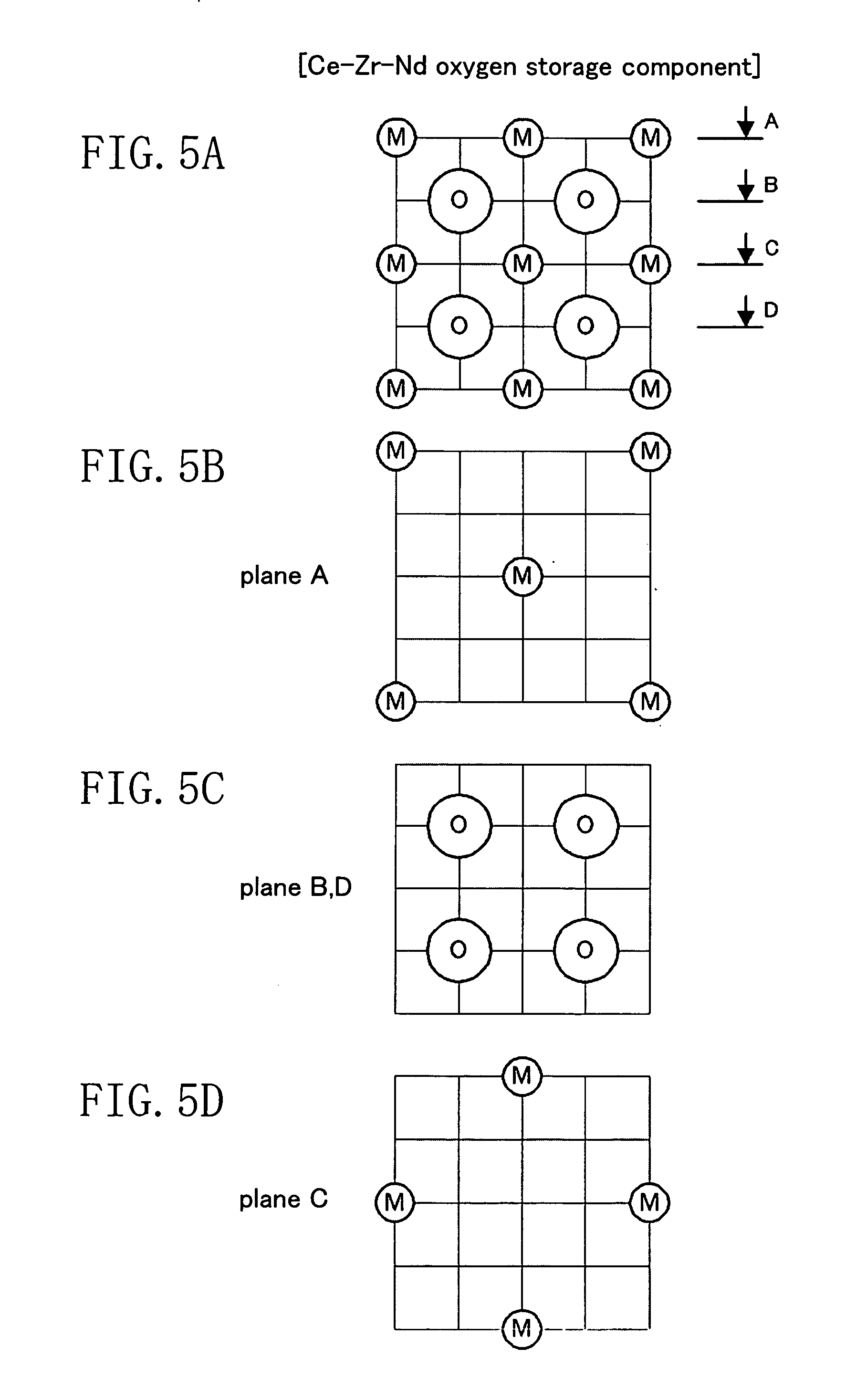Exhaust gas purification catalyst
a technology of exhaust gas and catalyst, which is applied in the direction of physical/chemical process catalyst, metal/metal-oxide/metal-hydroxide catalyst, separation process, etc., can solve the problems of deteriorating catalytic conversion performance, affecting the efficiency of catalytic conversion, and affecting the conversion efficiency of catalytic reactions, etc., to achieve excellent oxidation condition, increase the number of active sites, and high activity
- Summary
- Abstract
- Description
- Claims
- Application Information
AI Technical Summary
Benefits of technology
Problems solved by technology
Method used
Image
Examples
embodiment i
[0127]FIG. 1 shows a schematic structure of an automobile spark ignition engine 1 at which a three-way catalyst 11 according to this embodiment is mounted. Specifically, the engine 1 has a plurality of air cylinders 2 (only one shown in the figure) and is configured so that an air-fuel mixture of air supplied through an intake passage 3 and fuel supplied by a fuel injection valve 4 is explosively combusted in a combustion chamber 6 by spark ignition of an ignition plug 7 and the resultant exhaust gas is released to the air through an exhaust passage 8. The exhaust passage 8 is provided with a catalytic converter 10 and the three-way catalyst 11 according to the present invention is contained in the catalytic converter 10. The catalytic converter 10 is disposed in an upstream part of the exhaust passage 8 as much as possible, as by directly coupling it to the convergence of an exhaust manifold, in order to attain high conversion efficiency from just after start-up of the engine 1. As...
example 1
[0146] A three-way catalyst has two catalytic layers, upper and lower, as shown in FIG. 3 (see FIG. 9).
-Lower Catalytic Layer-
[0147] Ce—Zr—Nd mixed oxide: carried amount of 5.7 g / L
[0148] Pd / first alumina: carried amount of 50.0 g / L (Pd: carried amount of 0.7 g / L)
[0149] cerium dioxide: carried amount of 5.7 g / L
[0150] zirconia binder: carried amount of 8.5 g / L
-Upper Catalytic Layer-
[0151] Pt / second alumina: carried amount of 25.5 g / L (Pt: carried amount of 0.08 g / L)
[0152] Rh / Ce—Zr—Nd mixed oxide: carried amount of 56.0 g / L (Rh: carried amount of 0.1 g / L)
[0153] Rh / third alumina: carried amount of 17.0 g / L (Rh: carried amount of 0.04 g / L)
[0154] zirconia binder: carried amount of 11.0 g / L
[0155] The mass ratio expressed by ZrO2 / (CeO2+ZrO2+Nd2O3) in the Ce—Zr—Nd mixed oxide is 80 mass % for the upper layer and 67 mass % for the lower layer.
example 2
[0156] In the three-way catalyst as in Example 1, the lower catalytic layer further contains a Pd-carried Ce—Zr—La—Y-alumina compound at a carried amount of 25.0 g / L (of which the carried amount of Pd is 0.35 g / L) and the other components are the same as those in Example 1 (see FIGS. 9 and 10).
[0157] As shown in FIG. 11, in Example 2, the amounts of Pd carried per unit mass on the first alumina and the Ce—Zr—La—Y-alumina compound in the lower layer are A=0.70 / 50.0 and B=0.35 / 25.0, respectively, and therefore the relation A=B holds.
[0158] Further, the amounts of Rh carried per unit specific surface area (SSA) on the third alumina and the Ce—Zr—Nd mixed oxide in the upper layer are C=0.04 / 78 and D=0.10 / 17, respectively, and therefore the relation C
PUM
| Property | Measurement | Unit |
|---|---|---|
| temperature | aaaaa | aaaaa |
| temperature | aaaaa | aaaaa |
| length | aaaaa | aaaaa |
Abstract
Description
Claims
Application Information
 Login to View More
Login to View More - R&D
- Intellectual Property
- Life Sciences
- Materials
- Tech Scout
- Unparalleled Data Quality
- Higher Quality Content
- 60% Fewer Hallucinations
Browse by: Latest US Patents, China's latest patents, Technical Efficacy Thesaurus, Application Domain, Technology Topic, Popular Technical Reports.
© 2025 PatSnap. All rights reserved.Legal|Privacy policy|Modern Slavery Act Transparency Statement|Sitemap|About US| Contact US: help@patsnap.com



